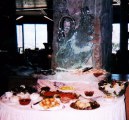Why ice-free water, and plenty of it, is important
DRINKING AND EATING DURING COLD WEATHER
Sure enough, winter has arrived. If we have not yet made arrangements to provide the horses ice-free water, now is the time. Early in the winter we always see an increase in the number of colic cases (stomachaches). These are never scheduled and are almost always found at night or on weekends. So, if you think we are encouraging you to provide a plentiful supply of ice-free water and plenty of roughage just because we are lazy, you are only partially right!
When the water suddenly freezes Dobbin is reluctant to drink the very cold water. Maybe it hurts his teeth, but whatever the reason, he drinks only part of the normal intake. As a result, he becomes a little dehydrated.
Part of the water consumed is utilized as lubricant in the bowel and helps the food, and eventually the waste materials, to move along. As the bowel drys, movement of the stool slows. As the bowel becomes full, the stool material is packed in tighter as it accumulates farther and farther up the tract. This starts what we call an impaction. Accumulating behind the impaction is gas, that is usually in small quantities and is rapidly expelled.
So now the horse not only feels very full, but is in pain due to accumulation of gas and stretching of the bowel. This is when Dobbin starts to show the dreaded signs of colic. He will be a little depressed and will often look at one side or the other, but usually the right side. He may lay down and get back up, trying to find a comfortable position.
-
This is the time to find help and start treatment, before he becomes more aggressive in his search for pain relief. If he starts rolling in an attempt to relieve the pain, the impaction will act like an anchor. It stays in place as the horse rolls around it, essentially twisting off the open end. Fortunately, most horses are found before going this far, but even early treatment can take some time to relieve the discomfort. The impacted contents of the bowel are so tight it is difficult for the stool softeners and lubricants to work their ways into and through the bowels. During the treatment, the horse must be kept comfortable so that he will not roll.
After hearing this terrible story, you probably would like to prevent the situation from occurring, just as we veterinarians would. If we provide water for the horses, and if they will drink it, the chance they will have a problem is small. Even if we provide the horse with ice-free water, it might not choose to drink it. We can encourage water consumption by adding salt to the feed. This tablespoon of salt in the grain each day is in addition to the trace mineral block that is always available. You can feed salt during the early part of winter until the horse becomes accustomed to the colder water. However, increased water consumption is good anytime, so feeding salt all winter will help guarantee drinking even when there is a very cold snap, etc.
Another way we can make life more comfortable for the horse is to see that he has access to plenty of roughage. The digestion of hay or grass creates much more heat within the body than grain, because they are in the bowel much longer. So, if you think there is need to increase the amount of food the horse eats during the winter, first increase the amount of hay until he is eating all he wants. If more is needed, then improve the quality. The better quality hay will provide more calories and protein when digested. While additional grain will provide the same, it is digested much faster so the horse enjoys only a brief rush of warmth from the digestion process.
These small changes in the feeding will make Dobbin more comfortable and reduce the worry over his health.
CLICK BELOW TO DISPLAY A PRINTER-FRIENDLY COPY OF THIS ARTICLE
Select "Open this file from its current location," if you just want to print it out,
it will open in a simple word processing application, select the print button.
(unless you want to save this article in your computer's memory)

 DRINKING_AND_EATING_DURING_COLD_WEATHER.rtf
DRINKING_AND_EATING_DURING_COLD_WEATHER.rtf